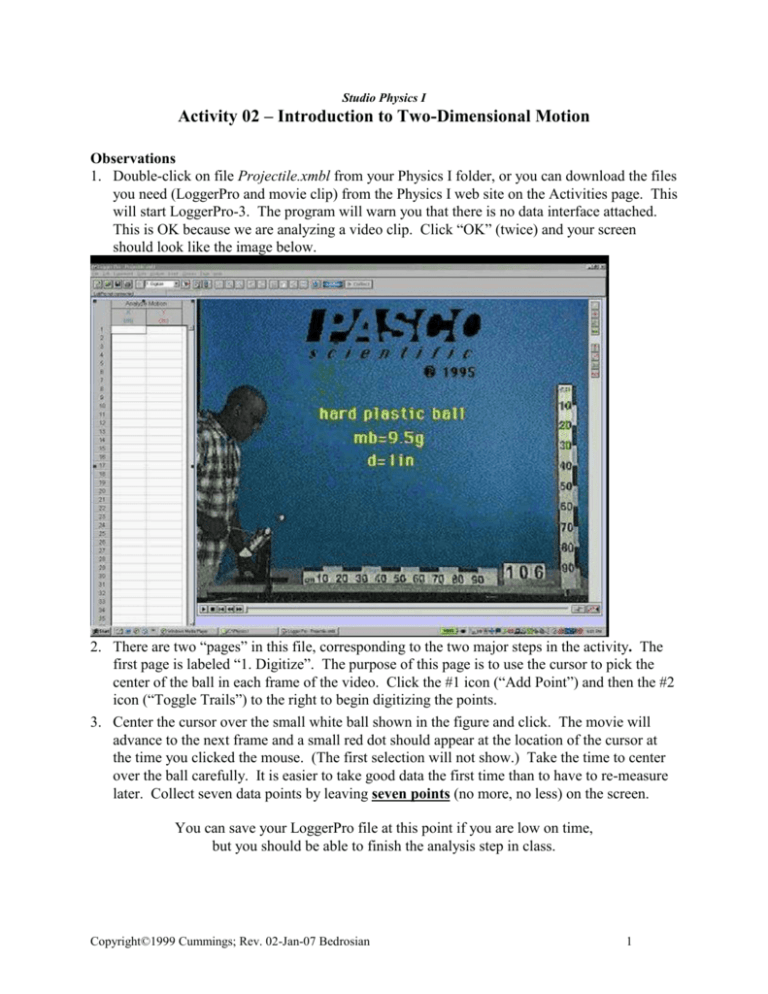Phys I Doc
advertisement

Studio Physics I Activity 02 – Introduction to Two-Dimensional Motion Observations 1. Double-click on file Projectile.xmbl from your Physics I folder, or you can download the files you need (LoggerPro and movie clip) from the Physics I web site on the Activities page. This will start LoggerPro-3. The program will warn you that there is no data interface attached. This is OK because we are analyzing a video clip. Click “OK” (twice) and your screen should look like the image below. 2. There are two “pages” in this file, corresponding to the two major steps in the activity. The first page is labeled “1. Digitize”. The purpose of this page is to use the cursor to pick the center of the ball in each frame of the video. Click the #1 icon (“Add Point”) and then the #2 icon (“Toggle Trails”) to the right to begin digitizing the points. 3. Center the cursor over the small white ball shown in the figure and click. The movie will advance to the next frame and a small red dot should appear at the location of the cursor at the time you clicked the mouse. (The first selection will not show.) Take the time to center over the ball carefully. It is easier to take good data the first time than to have to re-measure later. Collect seven data points by leaving seven points (no more, no less) on the screen. You can save your LoggerPro file at this point if you are low on time, but you should be able to finish the analysis step in class. Copyright©1999 Cummings; Rev. 02-Jan-07 Bedrosian 1 Analysis 4. Go to the spot labeled #3 above and switch to the second page, “2. Analyze”. The velocity and acceleration values have been calculated by LoggerPro-3 from the digitized values for X and Y using a finite difference formula. Note that this formula is most accurate for the middle data point, in this case the fourth point. From the data for the fourth point, find values for X and Y acceleration. If you picked the center of the ball carefully, both values should be negative, with the X value around –0.1 to –1 and the Y value around –8 to –12. 5. Use icon #4 above (“Curve Fit”) to match quadratic equations to the X and Y data points respectively. The quadratic equation is at2 + bt + c where a, b, and c are unknown constants. (You will get different values of a, b, and c for each curve, X and Y.) Find values of x0, v0,x, ax, y0, v0,y, and ay in terms of the quadratic coefficients a, b, and c for each curve. (Hint: Equation 2 on the formula sheet is a quadratic equation. Still confused? Check page 4.) Compare accelerations with your answers in step 4. They should be close, but not identical. Why are they not identical? 6. When we discuss projectile motion in class, we usually assume that ax = 0. Why? In this case, is the value of ax close to zero (within experimental error) or is it some positive or negative value? Explain. (The differences between your answers to 4 and 5 give you an estimate of the experimental error in your observations. Of the two answers, 5 should be more accurate.) 7. Compare the value of ay that you measured with what you expect from gravity. Is it within experimental error of the free-fall acceleration due to gravity? Copyright©1999 Cummings; Rev. 02-Jan-07 Bedrosian 2 EXERCISES: Projectile Motion 8. Pick the best answer to the following question and explain your reasoning. A boy standing on flat ground threw a baseball straight up to a maximum height of 20 meters and let it drop to the ground. It was in the air a total of t1 seconds. He then picked up the ball and threw it at an angle. It reached a maximum height of 20 meters and hit the ground 50 meters away. On the second throw, it was in the air a total of t2 seconds. Neglecting air resistance, which statement below is true? A) B) C) D) t1 > t2 . t1 = t2 . t1 < t2 . There is not enough information to determine whether A, B, or C is true. A woman playing handball hit a hard rubber ball with her hand and gave it an initial velocity of 20 m/s at an angle of 10° above horizontal. The ball hit a wall 10 m (horizontally) away from the woman’s hand. Use g = 9.8 m/s2 and neglect air resistance. Let x be the horizontal direction and y be the vertical direction (positive = up). 9. What is the x component of the initial velocity? 10. What is the y component of the initial velocity? 11. How long does it take for the ball to hit the wall? Explain your reasoning, don’t just write down some numbers. 12. How high is the ball above or below the height of the hand when it hits the wall? Explain your reasoning, don’t just write down some numbers. 13. When the ball hits the wall, is it still going up or is it on its way down? How do you know? Copyright©1999 Cummings; Rev. 02-Jan-07 Bedrosian 3 APPENDIX: Using Curve-Fitting Software for Data Analysis The purpose of any curve-fitting software is to approximate a set of discrete data points with a continuous curve of a defined mathematical form. The curve may not pass exactly through any of the points, but the various constants defining the curve are adjusted so that the curve passes as closely as possible to the set of points. The measure of the overall distance between the curve and the set of data points is the Root Mean Square Error, or RMSE as it is known in LoggerPro. The curve to be fit to the data points is represented as a mathematical expression involving constants (like a, b, c) and powers or other mathematical functions of the independent variable (like t). In the case we use for this activity, the expression is y = at2 + bt + c. It is vitally important to note that the choice of symbols (letters) used to represent this abstract mathematical curve is totally arbitrary and carries no inherent physical meaning. It is simply a mathematical way to represent a curve of a particular type. In this case, it is a quadratic curve (or parabola) and the three constants (a, b, c) simply represent the coefficient of the square of the independent variable (t2), the coefficient of the independent variable (t), and the constant coefficient, respectively, in the mathematical form of the curve. In the mathematical expression, y does not necessarily mean the physical coordinate in the vertical direction. It is simply the dependent variable. We might just as well have written f(t) = at2 + bt + c. Once we find a curve that is a good match to the data points, the next step is to interpret this mathematical curve as it relates to a particular physics formula. The variable names in the physics formula do have physical meaning, and so our task is to connect the values of coefficients in the mathematical expression as calculated by the program with the corresponding values in the correct physics formula. We match the values from the mathematical expression to corresponding quantities in the physics equation based on their respective roles in the equations, not based on the specific symbols (letters) we use to represent them. An example will clarify this. Suppose the curve-fitting software gives us the following equation from the data points we measured for horizontal position (x) versus time (t): y = at2 + bt + c. a = -0.5, b = 3.0, c = 2.5 Here is how we would match that information with the physics equation: y (0.5) t 2 (3.0) t (2.5) x x0 v 0, x t ( 12 a x ) t 2 Here are the values: x0 = 2.5, v0,x = 3.0, ax = –1.0 . Copyright©1999 Cummings; Rev. 02-Jan-07 Bedrosian 4






